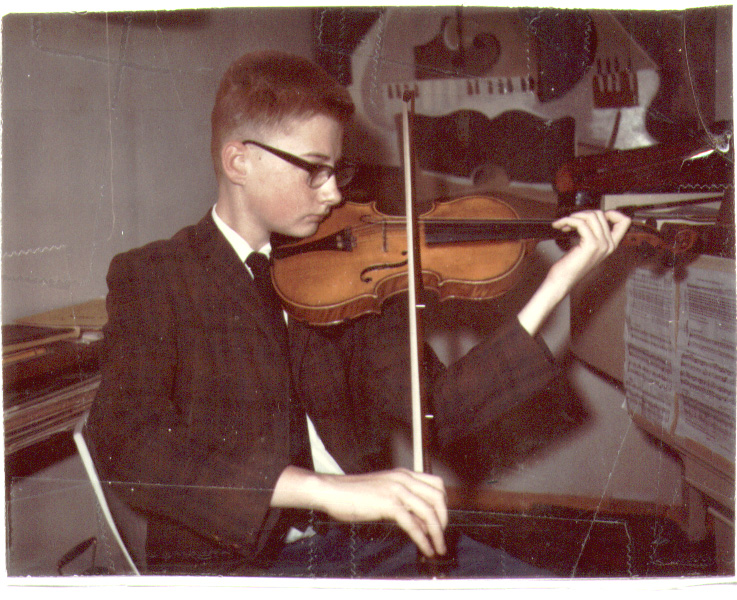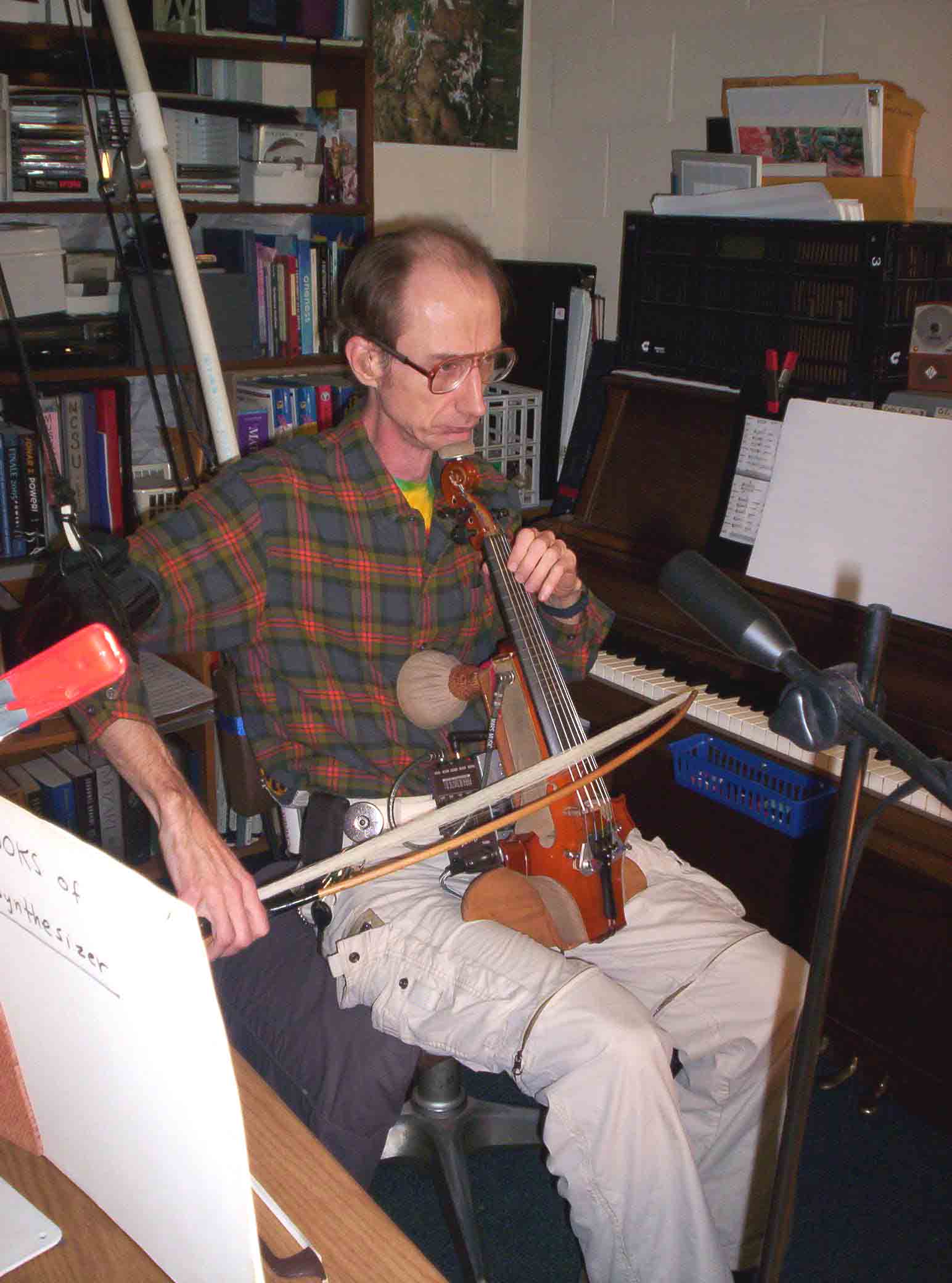10 Sonatas for Solo Violin or Viola
10 Sonatas for 6 String Violin
Five of the sonatas (violin edition, #4, 6, 7, 9 and
10) were premiered at Duke University on March 31, 2006
in a program with Eric Pritchard, three of his students,
and a friend of mine (Lin-Ti Wang). Eric played Sonatas
1, 9, and 10 on his faculty recital on January 14,
2007. You may see the program here. (Note that in the current edition, what had been Sonata 10 is now Sonata 9, and what was Sonata 11 is now Sonata 10.)
Eric
recorded
#1, 9, and 10 again in October 2009 with better
surroundings, more takes, and some engineering, so those
recordings are included here. I gave an introductory
talk in '06 (click here
for the recording) that may be a touch hard to
understand due to the heavy reverb in the hall. A better
recording (and shorter talk!) is from the '07 recital here.
On August 10, 2014, Eric premiered Sonata #3 at the
Unity Center of Peace in Chapel Hill NC, and the videos
are posted on my YouTube channel with links below. Many
thanks to the musicians.
Pritchard, three of his students,
and a friend of mine (Lin-Ti Wang). Eric played Sonatas
1, 9, and 10 on his faculty recital on January 14,
2007. You may see the program here. (Note that in the current edition, what had been Sonata 10 is now Sonata 9, and what was Sonata 11 is now Sonata 10.)
Eric
recorded
#1, 9, and 10 again in October 2009 with better
surroundings, more takes, and some engineering, so those
recordings are included here. I gave an introductory
talk in '06 (click here
for the recording) that may be a touch hard to
understand due to the heavy reverb in the hall. A better
recording (and shorter talk!) is from the '07 recital here.
On August 10, 2014, Eric premiered Sonata #3 at the
Unity Center of Peace in Chapel Hill NC, and the videos
are posted on my YouTube channel with links below. Many
thanks to the musicians.
Mary Kay Robinson performed the Sonata #4 in Brevard NC on February 15, 2009.
Below are links to all ten scores in PDF format, much more convenient than downloading each movement in Finale. (There had been 11 sonatas until late November 2015; I have eliminated the old Sonata #8, using its middle movement for the first movement of the old Sonata #9 to make the new Sonata #8. The old #10 and #11 are now #9 and #10.)
In 2002 I made a version of the first three sonatas for 6 string electric violin. In March 2017 I started a new attempt at playing violin again, which I did every ten years to no avail. In hopes of playing 6 string violin, I arranged all ten sonatas for 6 strings. However my arthritis once again made all this futile. Note that this arrangement has considerable differences from the original, in order to take full advantage of the instrument. In addition, in 2002 I arranged the Bach Sonata #1 and Partita #2 for 6 string violin, and I completed the difficult copywork into Finale on March 25, 2017. Those two arrangements have their own web page.
The arrangement of the ten sonatas for 6 string
violin led to major changes in several of the 4 string sonatas and
improvement in many details of the copy work, layout, and typo
correction. This led to the second edition of the ten sonatas in both
violin and viola versions. Earlier versions should be discarded. The
extant recordings are all of the first edition; it will take some time
to have recordings of the second edition.
Those violin sonatas that have not yet been performed are marked with an asterisk (*). None of the viola edition or 6 string versions have been performed or recorded to date (July 2022).
The cover photograph (included here to the upper right) is of me playing violin at age about 11.
The 10 Sonatas for violin and viola are available in legal-size (8.5"x14") and letter-size (8.5"x11")
formats. The legal-size has no page turns in each movement. The
letter-size has a few such page turns, but is suitable for electronic
music readers, and is more convenient for paper printing and binding.
The violin and viola editions are corrected to July 10, 2022.
10 Sonatas for Solo Violin Legal-size Score (PDF) Cover
Letter-size Score (PDF) Cover
10 Sonatas for Solo Viola Legal-size Score (PDF) Cover
Letter-size Score (PDF) Cover
10 Sonatas for 6 String Violin Legal-size Score Cover
(note;
all recordings are of the edition that was current at the time of
performance. Only Sonata No. 2 is of the current edition. The latest edition, from July 2017, has some new passages,
especially in the later sonatas. Only the 4 string violin sonatas have
been performed to date.)
|
Sonata No. 1 for Solo Violin:
|
Sonata No. 2 for Solo Violin: YouTube Video Recorded by Eric Pritchard (2020) |
| Sonata No. 3 for Solo Violin: (1) First Movement (Moderato) [2:28] YouTube Video (2) Second Movement (Slow) [3:11] YouTube Video (3) Third Movement (Vivace) [1:42] YouTube Video Performed by Eric Pritchard (2014) |
Sonata No. 4: Performed by Mary Kay Robinson (2009) |
*Sonata No. 5 for Solo Violin: |
Sonata No. 6:
[1:59] MP3 WAV Performed by Mingyi Huang (2006) |
|
Sonata No. 7 for Solo Violin: (2) Second Movement (Moderately Slow) (3) Goulash (Allegro quasi Bartokoid) [1:45] MP3 WAV Performed by Richard Zhu (2006)
|
*Sonata No. 8: (1) Death is Near (Dolce) [2:04] (2) Backfeifengesicht [1:40] (3) Third Movement (Moderato) [3:13] (4) Military Waltz (Allegro martelé ) [1:53] |
Sonata No. 9 for Solo Violin: [2:53]
MP3 WAV Performed by Eric Pritchard (2009) |
Sonata No. 10: (2)
Second Movement (Sprightly) [1:47] MP3 WAV (3)
Third Movement (Slow) [2:28] MP3 WAV (4) Finish With a Bang (Hayseedic) [1:03] MP3 WAV
Performed by Eric Pritchard (2009) |
 These solo violin sonatas were written between 1975 and 2003 in a rather complex pattern of
starts and stops, composition and disposal, editing and recopying. I wrote a
solo violin sonata in the spring of 1975, and based my now-eliminated First
Symphony based on its ideas; dissatisfied, I completely re-wrote it in January
1979, saving little from the original. I revised the first movement again in
the spring of 1991 and the last movement in 2002. The second sonata came along
in 1976, composed for Deborah Moreland’s 18th birthday as a
two-movement work. I rewrote both movements in 1991, and in 2002 reversed their
order and added a third movement written in 1991. (In addition, in 1975 I wrote
a sonata for solo ‘cello or viola, but discarded it later.)
These solo violin sonatas were written between 1975 and 2003 in a rather complex pattern of
starts and stops, composition and disposal, editing and recopying. I wrote a
solo violin sonata in the spring of 1975, and based my now-eliminated First
Symphony based on its ideas; dissatisfied, I completely re-wrote it in January
1979, saving little from the original. I revised the first movement again in
the spring of 1991 and the last movement in 2002. The second sonata came along
in 1976, composed for Deborah Moreland’s 18th birthday as a
two-movement work. I rewrote both movements in 1991, and in 2002 reversed their
order and added a third movement written in 1991. (In addition, in 1975 I wrote
a sonata for solo ‘cello or viola, but discarded it later.)
In 1979 I decided to write a total of 64
movements in 21 sonatas for solo violin, correlating each movement to a
hexagram of the “I Ching”—not by using chance to determine things, as John Cage
did, but just as a kind of unifying device and as an illustration of the nature
of each hexagram. As I finished the 21 sonatas, my arthritis became severe
enough that I could no longer play violin, and the sonatas remained unperformed.
In 1991 I made an electric violin which
I used for six months. It appeared that I was going to be able to play again,
so I went back to work on the 21 sonatas, throwing out the weaker movements,
rewriting those that had promise, and keeping the ones that were fine as they
stood. This made the new total of 16 sonatas with about a third completely new
material. However after this six month period I was no longer able to play,
both physically and due to other complications. At this time, when I was forced
to vacate my dwelling, my landlord threw away all my compositions that had been
copied in ink.
There followed ten years where making
music was not possible. In late 2001 and early 2002, I had a stable life
studying physics at NCSU, an old piano, housing, and access to a woodshop. I
made two electric violins, a 4-string and a 6-string, that I held like a cello,
with an assistive device to hold up my bow-arm. I could only play for a limited
time before it became too painful, but the new attempt at performance inspired
me to rework once again my old solo violin sonatas, including arrangements for
viola and 6-string violin. (I located two copies of the old 21 sonatas that I had
given to violinists, returned unperformed, and also recovered pencil drafts
from the 1991 revisions—thus recovering from the landlord’s editorial
judgment.) This led to once again throwing away weaker movements and a radical
re-ordering of the remaining ones in sets of three or four to make eleven
sonatas that were reasonably consistent. The grouping is arbitrary, though, and
in performance it is perfectly respectable for the violinist to pick whatever
movements seem appropriate and play them in the order of his or her choice.
By spring of 2003, it became clear that
the arthritis was too advanced and my attempt at a return to performance had to
end. Now I rely on others to perform.
In November 2015 I was making a revision of the copywork and making an experimental arrangement for cello, when I realized that the eighth of the eleven sonatas had two weak movements. I kept only the middle movement, and made what had been #9, 10, and 11 the new #8, 9, 10, with the old middle movement now the first movement of the new #8.
In
February 2017, I started to gather new instruments and adaptive gear
for a new attempt at playing violin, starting with a 6 string fretted
violin from China that I converted to 4 or 5 strings. Part of that
effort is to recopy the old
arrangements of the first three sontatas made in 2002 in ink, and
converting them to Finale, along with some improvements. In July 2017,
I completed all ten sonatas for 6 string, and finished the proofreading
by August 16. These are considerably
different from the originals in order to take full advantage of the new
instrument.
Many of the movements are intended to be performed with the "freeze"
sustain electronic effect, typically controlled by pedal. For
further details, please see the title page of the 6 string edition.
Unfortunately, I was unable to continue playing and had to quit in the
fall of 2017.






